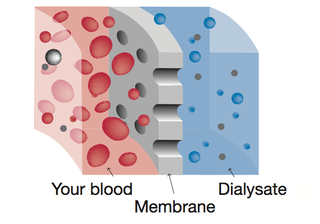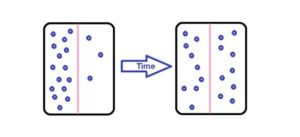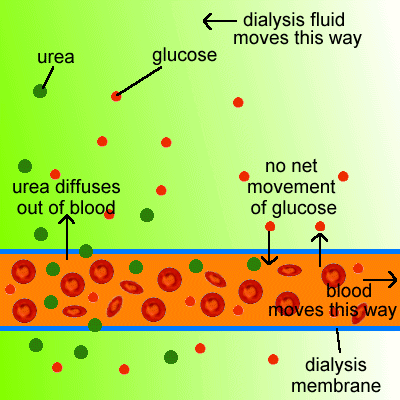What is dialysis?
Dialysis is an artificial method of filtering the blood to remove toxins, excess salts and water – in other words, the normal role of the kidneys. There are two types: haemodialysis (HD) and peritoneal dialysis (PD). This article discusses haemodialysis and how it works.
What does haemodialysis mean?
‘Haemo’, of course, means blood. ‘Dialysis’ means a separation (or filtration) process. It comes from a Greek word ‘dialusis’, meaning ‘to separate’.

A diagram showing how a haemodialysis machine works, with blood flowing in and out of the arm of a haemodialysis patient with a arterio-venous fistula (AVF).
1. Dialyser and dialysis fluid. Blood is removed from the patient’s fistula, and flows through an artificial kidney (called a dialyser); where it is kept separated from a cleansing fluid (called dialysis fluid, or dialysate) by ‘semi-permeable’ membrane. This is a layer of artificial or natural tissue with pores (holes) in it, which acts a filter, like sieve. Blood and dialysis fluid flow in opposite directions.
How dialysis happens is based on two principles ..
2. Basic principle of particle and pore size. The membrane has pores (holes) in it. In haemodialysis, these allow small particles to pass through, like water, urea, creatinine, salts (sodium, calcium and potassium), glucose and amino acids, but not large particles like protein or cells. In this way the membrane (with its pores) acts as a filter, in a similar way to the 1 million glomeruli (filtering units) in each kidney.

This is an artificial membrane within the dialyser. This is equivalent to the peritoneum in peritoneal dialysis, which is explained further in the how peritoneal dialysis works page.
3. Basic principle of diffusion. ‘Diffusion’ (movement) of particles across the semipermeable membrane is the second principle of dialysis. During diffusion, particles in areas of high concentration (in a liquid) move toward an area of low concentration.

Basic principle of dialysis – how diffusion happens (the ‘teabag effect’)
Picture how a tea bag work. The leaves stay in the bag, and the tea enters the hot water. In dialysis, waste in your blood moves towards the dialysis fluid, which is a drug solution that has no (or very little) waste.
How much waste is removed depends on the amount of the waste, the size of the pores (holes) in the membrane, what’s in the dialysis fluid, and – like a tea – the length of treatment. The ‘tea leaves’ (cells and proteins, for example) stay in the blood as they are limited by the size of the pores.
4. Dialysis fluid– contains:
- A glucose concentration similar to a normal level in the blood
- Concentration of salts, some of which are higher (calcium), some lower (potassium) and some the same as (sodium) found in normal blood
- No urea and creatinine (toxins).
Therefore, through the basic principle of diffusion (above) ..
5. Glucose. As dialysis fluid contains the same concentration of glucose as blood, there is no net movement of glucose out of the blood by diffusion.

Movement of glucose and urea (toxin) across a haemodialysis membrane
6. Toxins. The dialysis fluid contains no urea and creatinine. So both diffuse out of the blood into the dialysis fluid; from the high concentration in the blood, to the lower concentration in the dialysis fluid.
7. Salts – are more complicated. The concentration of salts are different. Compared to blood, some of are higher (calcium), some lower (potassium) and some the same as (sodium) in dialysis fluid.
So, again, through the basic principle of diffusion (above) .. calcium passes into the blood, potassium out of it, and sodium does not pass either way.
8. Clean blood– is returned, with the adjustments made above, to the patient’s fistula. And the waste dialysis fluid is disposed of.
[“Phew! Easy?! No way”. CKDEx Ed].
When do you need to start dialysis (or a kidney transplant)?
If you reach Stage 5 CKD, doctors consider you to be in end-stage renal disease (ESRD) or kidney failure. At this point, the kidneys are carrying out around 10% to 15% of their normal function. This is not enough to stay well. So you will need to start dialysis (or have a renal transplant).
If you have haemodialysis, most patients require 4 hours of dialysis three times a week. This provides about 5% kidney function (as does peritoneal dialysis). Whereas a well functioning kidney transplant provides 50% of the function of two normal kidneys.
Dialysis (or a transplant) can help you feel better and live longer, but they are not cures for kidney failure.
So. How does haemodialysis work?
Haemodialysis provides about 5% of the function of two kidneys, as does peritoneal dialysis. A well functioning kidney transplant provides 50% of the function of two healthy kidneys. Dialysis is started when kidney function is abut 10-15% of normal (i.e. CKD5).
In this way these treatments do not cure kidney failure. They just control its symptoms, and can keep you well for many years.
https://www.youtube.com/watch?v=shFSW8VE3Gs&t=28s
Last Reviewed on 14 September 2023
